Mathematical Manipulatives: Tools for Engaging Learning
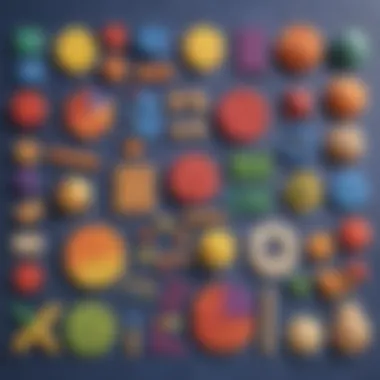
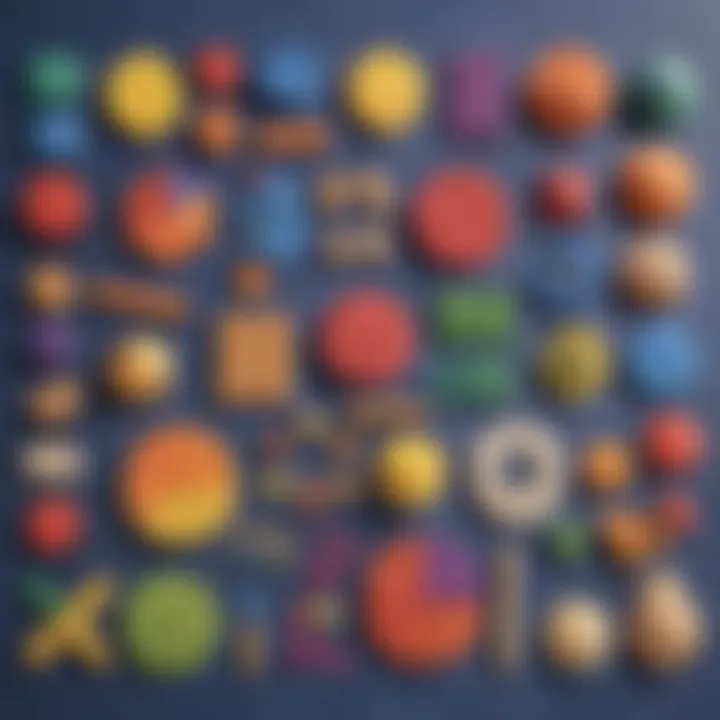
Intro
Mathematics often conjures images of dry formulas and endless calculations. Yet, within the realm of teaching math, a shift is happening. The integration of tactile tools—known as mathematical manipulatives—brings to the fore a vibrant way to grasp numerical concepts. These hands-on tools can bridge the gap between abstract ideas and tangible understanding, making arithmetic accessible and intuitive for young learners. They not only offer a visual representation of mathematical concepts but invite kids to engage in a more interactive and experiential form of learning.
By touching, moving, and manipulating these tools, students can develop a foundational grasp of vital math principles, laying the groundwork for future academic success. Whether you’re a parent, teacher, or caregiver, incorporating manipulatives can transform the way children relate to mathematics, making learning a more enjoyable pursuit.
In this exploration, we will delve into various types of manipulatives, their role in enhancing cognitive skills, and effective ways to integrate them into everyday learning activities.
Interactive Learning Games
Games that encourage interaction provide a delightful approach to learning. They blend fun with education, making children eager to tackle challenging math concepts.
Popular Games
Some favorites include Math Bingo, Fraction War, and Multiplication Pictionary. These games capitalize on competition and teamwork to help children practice their skills and reinforce learning in a lively way.
Description of Top Educational Games
- Math Bingo: This classic game encourages kids to recognize numbers and mathematical operations. Players mark spaces on their cards based on their calculations, fostering quick thinking and problem-solving.
- Fraction War: Using a standard deck of cards, children can compare fractions based on values assigned to both the cards and the fractions themselves, encouraging deeper understanding of fraction concepts.
- Multiplication Pictionary: Teaming up, one player draws a visual for their chosen multiplication facts while teammates guess the equation, merging creativity with math practice.
Benefits of Playing Educational Games for Kids' Cognitive Development
Games like these have multifaceted advantages.
- Enhanced Engagement: They motivate kids by adding an element of excitement.
- Improved Critical Thinking: Games often require strategizing, leading to heightened analytical skills.
- Social Skills: Many games involve teamwork, helping children learn to collaborate and communicate effectively.
Game Reviews
Each game offers unique benefits, but understanding their effectiveness hinges on various factors such as ease of setup and adaptability to different learning styles.
In-depth Reviews of Selected Educational Games
- Math Bingo: Simple to set up and customize, it caters to different math levels but can become repetitive without enhancements.
- Fraction War: This game sparks a love for fractions but may require adjustments for younger children who struggle with initial concepts.
Comparison of Gameplay and Learning Outcomes
Both Math Bingo and Fraction War enhance number recognition. However, Fraction War deepens understanding of fractions through comparison, while Multiplication Pictionary emphasizes creativity alongside math skills, catering to visual learners.
"Using manipulatives and games in education is akin to planting a seed. With the right nurturing, it can grow into a flourishing understanding of mathematics."
Educational Topics
A rich variety of topics encompasses the world of mathematical manipulatives.
Compilation of Articles Covering Various Subjects Like Math, Science, Languages, etc.
Manipulatives can be effectively applied not just in mathematics but across various subjects, enriching a child’s overall learning experience. Consider how science experiments can be structured using simple household items, or language learning can be enhanced through interactive role-play games. Each subject can truly benefit from connective and hands-on engagement.
Importance of Interdisciplinary Learning for Holistic Development
This approach allows children to see connections between different subjects, fostering critical thinking and problem-solving skills. Coordinating math with art or science shows learners that knowledge is not confined to specific boxes, making it more relevant to their daily lives.
Tips and Tricks
Practical Tips for Parents and Educators to Enhance Children's Learning Journey
- Integrate Manipulatives Consistently: Regular use helps students associate tools with specific math concepts.
- Encourage Exploration: Allow children to use manipulatives freely, prompting curiosity and discovery.
- Connect to Real-World Examples: Relate math concepts with everyday scenarios, incorporating manipulatives to illustrate these ties in a hands-on way.
Strategies for Making Learning Fun and Engaging
- Create Themes: Design lessons around seasons or holidays using tailored manipulatives.
- Incorporate Technology: Use apps alongside physical manipulatives to diversify the learning experience.
Creative DIY Projects
Step-by-Step Guides
Hands-on activities can be both educational and entertaining. Projects like creating a DIY abacus using beads and string not only teach counting but also motor skills.
Benefits of Hands-On Activities for Children's Cognitive and Motor Skills
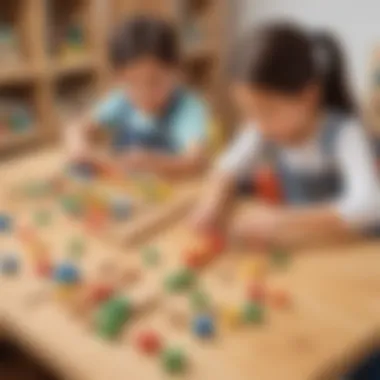
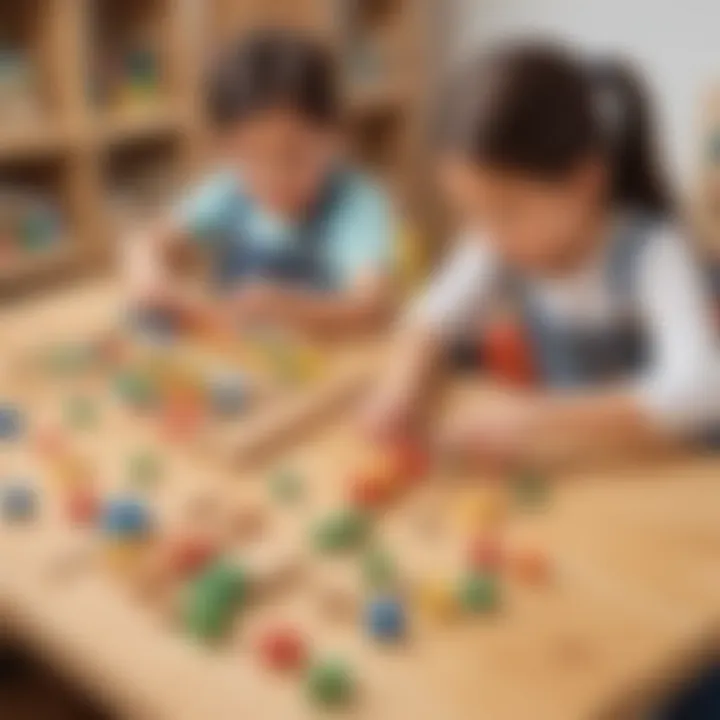
Participating in these projects enhances focus, dexterity, and reasoning skills, moving kids from passive learners to active creators.
Craft Ideas
Enlist items around the house—like empty cereal boxes or buttons—to foster creativity while embedding math learning.
Importance of Artistic Expression in Children's Development
Engaging in arts and crafts allows kids to explore their emotions and thoughts, leading to well-rounded personal development while juggling the complexities of mathematical reasoning.
Through these hands-on tools and creative outlets, children embark on a journey where learning math becomes a fascinating adventure, filled with opportunities for growth and understanding.
Preface to Mathematical Manipulatives
Mathematical manipulatives are potent tools that can transform the learning environment, making abstract concepts more tangible and relatable for students. This article delves into their critical role in enhancing the learning of mathematics, especially for young minds. When students engage with these hands-on tools, they often find themselves grasping complex ideas that might otherwise seem daunting. By incorporating such manipulatives into education, we not only enrich students’ understanding but also foster a more inviting atmosphere for exploration.
By promoting tactile interaction, manipulatives enable learners to visualize and experiment with mathematical principles. This is particularly vital in early education, where foundational skills are established. Whether it's stacking blocks to understand addition or using counters for subtraction, these activities can change the game for students struggling with traditional instruction methods. The following sections will outline various types of manipulatives, their historical background, and the multitude of benefits they offer in educational settings.
Definition and Overview
So, what exactly qualifies as a mathematical manipulative? In simple terms, these are physical objects that students can handle to better visualize and comprehend mathematical concepts. Think of things like colorful blocks that can help kids learn addition by combining different sets, or number lines that allow them to measure distances between numbers dynamically.
Manipulatives come in various forms, such as:
- Pattern blocks for geometric understanding
- Base ten blocks to illustrate the place value system
- Counters or beads for counting and simple operations
- Fraction pies that aid in grasping fractional relationships
The beauty of manipulatives lies in their ability to cater to varying learning styles. Not all children grasp concepts the same way; some are visual learners while others are kinesthetic. Therefore, manipulatives serve as a bridge, meeting students where they are, and guiding them toward mathematical clarity.
Historical Context
The use of manipulatives isn't a modern invention; its roots can be traced back centuries. Early educators recognized the value of hands-on tools, and societies such as the ancient Greeks and Romans employed physical objects for teaching arithmetic. However, the systematic implementation of manipulatives in classrooms gained momentum in the 20th century.
In the 1950s and 1960s, educational theorists discovered the richness manipulatives brought into the learning processes. The Dienes method introduced various types of blocks that helped students develop an understanding of mathematical ideas through play and exploration rather than rote memorization. Fast forward to today, manipulatives are not just a novelty; they’re embraced in various curricula worldwide as integral to effective math education.
"Learning is a treasure that will follow its owner everywhere." - Chinese Proverb
As education continues to evolve, recognizing the historical significance of manipulatives reminds us that hands-on learning experiences are foundational. Educators today can build on these historical insights to craft modern learning environments rich with exploration and understanding.
Types of Mathematical Manipulatives
Understanding the various types of mathematical manipulatives is crucial because it reveals the tools available for facilitating hands-on learning experiences. Each type of manipulative serves a specific purpose, allowing learners to grasp mathematical concepts with greater clarity. These tools not only make abstract ideas more tangible but also cater to different learning styles. This section elaborates on the benefits and considerations relevant to specific types of manipulatives.
Blocks and Tiles
Blocks and tiles are often favored in early mathematics education due to their versatility. They come in various shapes, sizes, and colors, allowing children to engage in activities that build foundational skills. For instance, when tackling concepts like addition or subtraction, educators can have students physically combine or separate blocks. This hands-on approach deepens understanding by providing a visual and tangible representation of the problems at hand. When students see two blocks being added to three others, they instantly relate to the concept of merging quantities. Moreover, it can be said that the tactile sensation of arranging these pieces promotes spatial awareness and fosters an understanding of symmetry and geometric principles.
Counters and Beads
Counters and beads possess a simplicity that belies their effectiveness. These small objects can represent quantities and be used to illustrate counting principles, basic operations, and even fractions. For example, a child can use five counters to visualize the equation 2 + 3. By manipulating the counters, they can physically see the groupings and understand the end result is indeed five counters altogether. Furthermore, beads can also be strung on a wire to form patterns, which introduces learners to the beginnings of repetition and sequences. The engaging nature of these manipulatives makes them particularly beneficial in settings where children may struggle with attention or motivation.
Geometric Shapes
Geometric shapes provide a concrete means of exploring spatial relationships and properties. Using a set of different geometric shapes, educators can guide children in identifying characteristics such as edges and vertices, thus laying the groundwork for geometry comprehension. For instance, through sorting and classifying triangles and quadrilaterals, students can engage in meaningful discussions around angles and symmetry. To enhance this experience, educators can organize activities where students build structures using these shapes, fostering creativity while reinforcing mathematical principles. It’s a simple but effective way to stimulate both imagination and intellect.
Number Lines
Number lines serve as powerful visual tools that help students grasp the concept of ordinality and the relationship between numbers. Drawing a number line on a board, teachers can illustrate addition and subtraction operations. For instance, if a child is asked to solve the problem 4 + 3, they can physically count forward on the line, which reinforces the idea of number sequences. Furthermore, representing negative numbers is a breeze with number lines, as they offer clear visual representation that makes abstract concepts more accessible. The linear nature of number lines aligns well with how we typically perceive sequences, making it an intuitive tool for learners.
Interactive Digital Manipulatives
As technology continues to infiltrate educational spaces, interactive digital manipulatives are gaining traction in classrooms. These tools range from simple apps to complex software designed to mimic physical manipulatives. An example would be virtual blocks used in a tablet application, where users can combine shapes or solve mathematical challenges. Not only do digital manipulatives draw students in with their engaging interfaces, they also allow for immediate feedback, which is instrumental for learning. There's also the added advantage of easy customization—adjusting difficulty levels to suit diverse learning paces is a cinch.
Benefits of Using Manipulatives in Learning
In today's educational landscape, addressing the needs of diverse learners is more crucial than ever. Mathematical manipulatives stand out as effective tools that can foster deeper understanding in mathematics. This section dives into the myriad ways these hands-on resources enhance learning.
Enhancing Conceptual Understanding
Manipulatives provide the tangible experiences that many students need to solidify abstract mathematical concepts. Whether it’s using blocks to demonstrate addition or employing number lines to visualize fractions, these tools enable learners to physically interact with the material. Instead of passively absorbing information, students actively engage with mathematical ideas, thus leading to a stronger grasp of topics. It’s one thing to memorize a formula and another to visualize it in action. For example, a child might understand that adding two plus two equals four by seeing how two blocks added to another two blocks visually fills a space. This kind of engagement helps students internalize concepts which can often seem elusive through traditional methods.


Promoting Active Learning
Learning through manipulatives naturally promotes an active environment. Students are not merely spectators; they are the participants in their own learning journey. This hands-on approach encourages experimentation, where children can discover outcomes based on their actions. For instance, if a child uses counters to find out how many groups of three can be made from a set of twelve, they engage in problem-solving that goes beyond rote practice. Moreover, this type of learning often leads to questions that deepen understanding. Instead of simply answering “What is two times three?”, a child might wonder, “What other ways can I make six?” This exploration is vital for nurturing curiosity and encouraging a love for learning.
Fostering Critical Thinking Skills
Another significant benefit of manipulatives is how they promote critical thinking. When students interact with physical representations of mathematical concepts, they are more likely to analyze situations and hypothesize outcomes. For example, using geometric shapes to create patterns encourages students to think about relationships between shapes, spatial reasoning, and even algebraic functions. A student might experiment with combining triangles and rectangles to form larger shapes, questioning the properties that define each. This kind of inquiry cultivates a mindset geared towards exploration rather than just memorization, equipping learners with essential thinking skills for future challenges.
Improving Retention Rates
Research has consistently shown that active involvement in learning improves retention. When students manipulate objects, they create multisensory experiences that facilitate memory recall. Take, for instance, the use of fraction tiles. When a learner physically splits tiles into different portions, they are more likely to remember the concept of fractions for longer periods. The brain tends to retain information that is personally meaningful, and manipulating physical items allows students to form connections that have long-lasting impacts. As a result, these children often face less difficulty when faced with new and related mathematical concepts.
"Hands-on learning isn't just about making a mess—it's about making sense."
Practical Applications of Manipulatives
Mathematical manipulatives represent more than just tools; they embody a philosophy of interactive learning that aims to bridge the gap between theoretical mathematics and practical understanding. Their application can enrich educational experiences, making complex concepts more relatable and comprehensible for young learners. By embracing this hands-on approach, educators can foster a deeper appreciation for mathematical structures while promoting an inclusive and engaging atmosphere in the classroom.
Inclusive Learning Environments
One of the standout features of manipulatives is their versatility in catering to diverse learning needs. Not all students grasp concepts the same way, and manipulatives provide alternative pathways for understanding. For instance, consider a class where students present varying levels of mathematical skills—from those who breeze through addition to others who struggle with basic operations. Using colorful counters, educators can create a more equitable learning environment. These tools allow students to visualize problems and solutions, which can be particularly helpful for visual learners or those with learning disabilities. Building a community where each child can thrive, manipulative tools support differentiated instruction, thus ensuring no one is left behind.
Moreover, manipulatives can effectively address cultural and linguistic diversities. When teaching addition, for instance, instead of solely verbal instruction, a teacher might use blocks to seize attention and demonstrate the concept of combining quantities. This concrete representation resonates across ages and backgrounds, making math feel less alien and more accessible. The true strength lies in the ability of manipulatives to foster inclusivity, allowing every child a seat at the mathematical table.
Manipulatives in Group Activities
Working in groups can enhance the educational experience. When manipulatives are used in collaborative settings, students can engage in discussions, share ideas, and collectively solve problems. Picture a classroom where small groups tackle a math challenge using a variety of manipulatives. For example, when exploring fractions, students can use fraction tiles to manipulate and compare different parts of a whole. In such scenarios, the physical act of moving tiles promotes conversations and dialogue. Group work encourages students to voice their thoughts, listen to perspectives, and ultimately build on each other's ideas. This form of social interaction is crucial as it cultivates not only mathematical skills but also essential social skills, like teamwork and communication.
Additionally, group activities centered around manipulatives can help establish peer tutoring opportunities. When more advanced students assist their peers with understanding properties and operations, they strengthen their own knowledge while providing support. This symbiotic relationship can mimic real-world situations where collaboration is key to success.
Individual Exploration and Discovery
While group settings are beneficial, the individual exploration with manipulatives deserves attention as well. In quiet moments of self-discovery, students can engage with materials at their own pace, unraveling the intricacies of mathematics independently. Picture a student working alone with algebra tiles to solve equations—this freedom fosters a sense of ownership over one's learning. Here, manipulatives offer a scaffold for students to hypothesize, experiment, and explore mathematical concepts freely.
This independent play with manipulatives reinforces a concept known as constructivism, where learners build their own understanding based on experiences and actions. It allows for experimentation without immediate evaluation, reducing anxiety often felt during math tasks. Students can observe patterns and develop strategies organically. For example, if a child is investigating the concept of area, using grid paper and square tiles, they can physically cover the area and compare results without being rushed.
In essence, practical applications of manipulatives serve a crucial role across varied learning contexts. They enhance inclusivity, encourage collaborative learning, and promote independent exploration—all fundamental elements for nurturing engaged, confident mathematicians. As we look to the future of educational strategies, the place of manipulatives remains not only relevant but vital.
Strategies for Implementing Manipulatives in Education
Implementing mathematical manipulatives in education requires careful thought and consideration. Taking the right steps can turn an ordinary lesson into an exciting exploration where students gain a better grasp of mathematical concepts. It's not just about having these tools; it’s about using them effectively in ways that truly resonate with young learners. Here, we will delve into crucial strategies that can make this happen.
Choosing the Right Manipulatives
Selecting the appropriate manipulatives is a critical first step. Consider the age group, learning objectives, and individual student needs. For instance, young children might benefit from using colorful counting bears or blocks to understand basic arithmetic. These manipulatives allow children to physically group numbers and visualize addition and subtraction.
The type of manipulative should align with the mathematical concepts being taught. For example, for geometry lessons, teachers might choose geometric solids or pattern blocks, allowing students to explore shapes in a tangible way. On the other hand, for older students tackling algebra, algebra tiles could come in handy. They can represent variables and constants clearly, making abstract concepts more concrete.
When selecting materials, don't forget to involve students in the decision-making. Their input can spark interest and ownership over their learning. This could be something simple, like asking them if they prefer using digital tools or hands-on objects. An enthusiastic learner often leads to a more engaged classroom.
Integrating with Curriculum Standards
To ensure manipulatives are effective, integration with the curriculum standards is essential. This means understanding what the educational goals are and aligning the use of manipulatives to meet those objectives. For instance, if a teacher is focusing on problem-solving skills as outlined in the curriculum, incorporating tasks that allow learners to use manipulatives in solving real-world problems can be beneficial.
Teachers can create lesson plans where manipulatives serve as the core of the learning activity rather than just an add-on. For example, in teaching fractions, manipulatives like fraction circles can provide an interactive means for students to visualize and grasp how fractions work. They make the learning experience more relevant and effective, ensuring that the teacher meets educational benchmarks while enhancing student interactions.
Assessing Student Understanding
Once manipulatives are implemented, assessment of student understanding becomes vital. Evaluating how well students are grasping concepts can be done in various ways. Informal observations during group work can provide insights into how students are engaging with the manipulatives and whether they are on the right track. It’s important to watch for both enthusiasm and confusion as these can indicate understanding or a lack thereof.
Structured activities using manipulatives can be employed followed by quick assessments. Perhaps a teacher could ask students to represent a problem using their manipulatives, then explain their reasoning. This not only checks comprehension but also encourages communication skills.
Peer assessments can also foster collaboration and enhance understanding. When students explain their working methods to each other, they solidify their own understanding and uncover gaps in their knowledge.
"The use of manipulatives not only makes learning mathematical concepts more enjoyable but also offers a window into students’ thought processes."
Challenges and Limitations
In the realm of education, mathematical manipulatives serve as valuable tools that engage students in hands-on learning. However, as with any method, there are challenges and limitations that educators, parents, and caregivers must navigate. Understanding these hurdles is crucial to effectively implementing manipulatives in the classroom or at home.
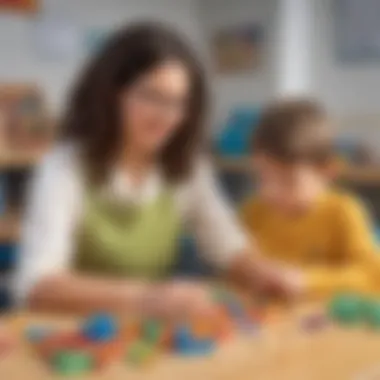
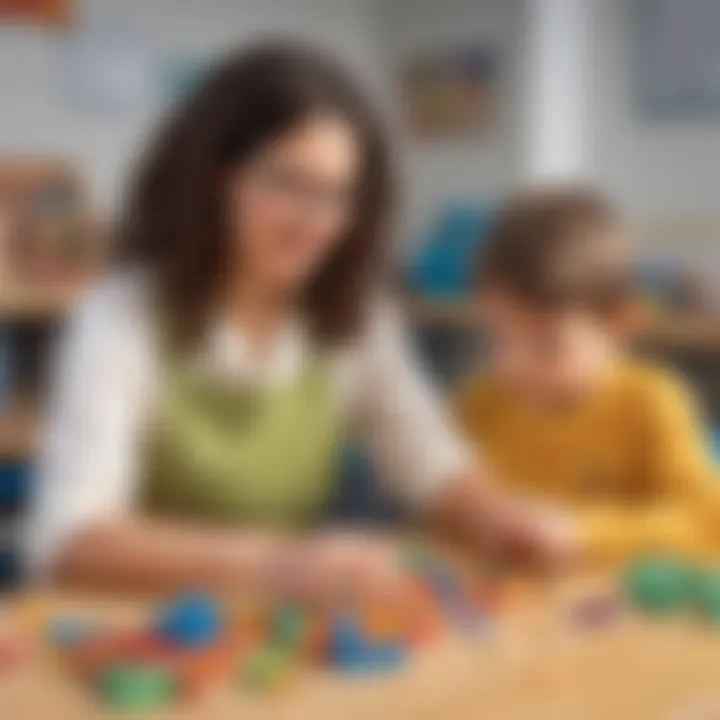
Resource Availability
One significant hurdle is the availability of manipulatives. Schools often find themselves with limited budgets, which can restrict the range of manipulatives they can provide. Some districts might prioritize electronic learning tools over physical ones, and while technology has its own merits, it can lead to neglecting that tactile, hands-on experience that manipulatives offer. Without adequate resources, the potential for hands-on learning diminishes.
Parents and teachers might need to get creative to bridge this gap. Community involvement can play a key role here. For instance, local businesses or nonprofits could sponsor math workshops, providing both materials and training. Individuals can also tap into everyday items. For example, pasta shapes can be used for basic counting or grouping exercises, demonstrating how flexibility in resourcefulness can confront this challenge.
Teacher Training and Preparedness
Equipping teachers with the right tools is one side of the coin; the other is training them effectively on how to use these tools. Unfortunately, many educators are not trained in the effective application of manipulatives. They might understand the concept but falter when integrating these into lessons. This brings about a situation where manipulatives become mere props—used without intention or strategy.
Teacher preparation programs often have overlooked this aspect of teaching mathematics. Adequate training can include workshops, online courses, or even peer mentoring. Training isn’t just about showing how to use the tools; it’s about fostering a mindset that embraces tinkering and exploration in learning. Evidence shows that when teachers are well-prepared, students reap the benefits, developing a deeper understanding of mathematical concepts.
Balancing Manipulatives with Traditional Methods
There’s also the delicate balance between using manipulatives and traditional methods of instruction.** Too much reliance on one can overshadow the other.**
While manipulatives can make concepts tangible, students also need to learn abstract thought processes. Relying solely on physical objects may lead to difficulties when they are asked to solve problems without them.
The key is to blend both approaches. Embedding manipulatives in lessons, while gradually introducing more abstract methods, allows students to develop a well-rounded mathematical foundation. For instance, after using blocks to understand addition, teachers can prompt students to try these problems on paper and connect the two methods. Finding the right mix requires thoughtful planning and should evolve as the students progress.
Maintaining that balance ensures students not only grasp concepts fully but assert confidence when facing mathematical challenges both with and without their hands-on tools.
Future Directions in the Use of Manipulatives
As we inch forward in the educational landscape, the role of manipulatives in teaching math seems destined for transformation. It's not just about using physical objects to grasp concepts anymore; rather, we're entering a new frontier where technology, research, and community involvement are reshaping the effectiveness of these tools in nurturing mathematical understanding in children. The implications are vast, catering not just to educational institutions but extending to parents and community members who are pivotal in a child’s learning journey.
Technological Innovations
Technological advancements are ushering in a fresh wave of manipulatives that blend tactile interaction with digital experiences. These innovations include applications and interactive software that allow children to manipulate numbers and shapes right on a screen. Imagine a child dragging virtual blocks to solve equations or using augmented reality to explore geometric shapes in three-dimensional space. This new approach can bridge gaps where traditional methods may fall short.
Moreover, devices like tablets can host various platforms, giving instant feedback—something that is invaluable for learning. Educators have opportunities to selectively integrate these high-tech tools according to curriculum requirements, creating a more personalized learning environment. Innovative designs, such as apps targeting specific math skills, can adjust complexity based on the child's progress, fostering a sense of achievement.
Research and Development
Continuous research in this area is vital for refining manipulatives. Academic studies dissect how children engage with these tools, identifying what works and what doesn’t. Insights gleaned from these studies help design better manipulatives tailored to children's needs. For instance, researchers discovered that younger students benefit from color-coded systems because it simplifies their cognitive load. The development of more sophisticated manipulatives, based on sound research, can also spell a difference in encouraging diverse mathematical thinking and problem-solving approaches.
Teachers can leverage findings from such studies, ensuring they choose manipulatives that align with the latest educational theories and classroom practices. Furthermore, collaboration between educational institutions and developers can lead to groundbreaking products that meet the evolving needs of learners, ensuring manipulatives are not just effective but also engaging.
Community and Parental Involvement
Community and parental involvement is another essential aspect of the future fortunes of manipulatives. Transitioning from a standard classroom setting to a home environment can greatly enhance learning. Parents can engage in their child’s education by utilizing manipulatives at home, reinforcing what they learned in school. Simple tools, like counters or measuring tapes, can provide real-world context to academic concepts. Encouraging families to participate in math-related activities fosters a supportive atmosphere around learning.
Additionally, communities can organize workshops or events that focus on these hands-on tools. By making manipulatives accessible through local libraries or community centers, it creates an inclusive approach where more children can benefit. Parents and guardians are encouraged to explore alternative methods for engaging with math, making it less intimidating and more approachable.
The future of manipulatives lies in their evolution, powered by technology, informed by research, and enriched by community engagement.
In summary, the future directions in the use of mathematical manipulatives look promising and multifaceted. By embracing technology, fostering continuous research, and involving families and communities, we broaden the horizons of how children interact with mathematics. The integration of these elements can make the learning process more dynamic and effective, ensuring that the next generation is not only well-versed in math but also enthusiastic about learning.
Finale and Implications for Educators
The role of manipulatives in education isn't just a passing trend. It’s rooted in a deep understanding of how children learn. As educators, recognizing the value that mathematical manipulatives bring to the table is crucial in shaping effective learning environments. These hands-on tools engage learners physically and mentally, allowing them to grasp abstract concepts through tangible means.
When we summarize the key insights from incorporating manipulatives into mathematical teaching, several elements emerge:
- Tactile Learning: Children often find it easier to understand complex ideas when they can physically manipulate items. This hands-on approach caters to various learning styles, particularly for those who struggle with traditional methods.
- Collaborative Learning: Utilizing manipulatives encourages group work and discussion among peers. This camaraderie promotes critical thinking and helps learners articulate their thought processes.
- Retention Improvement: Studies show that using manipulatives can significantly boost memory retention. By connecting concepts with physical actions, children are likely to remember what they've learned more effectively.
"Hands-on learning fosters curiosity, igniting a passion for discovery in every child."
In addition, educators should consider certain aspects when integrating these tools into their teaching:
- Alignment with Curriculum: It is essential that the manipulatives used align with curriculum standards to ensure a cohesive learning progression.
- Diverse Options: Consider varying types of manipulatives to cater to a diverse classroom. What works for one group might not fit another, and flexibility is key.
- Ongoing Assessment: Continuous assessment will help educators understand how well students are grasping concepts while using manipulatives. This can refine teaching practices and lead to better outcomes.
Summarizing Key Insights
Reflecting on the benefits of manipulatives reveals several major insights. One significant takeaway is that they bridge the gap between visual, auditory, and kinesthetic learners. Whether it’s blocks, counters, or digital tools, these resources are effective in driving comprehension. Furthermore, manipulatives can be adapted to suit lessons, making them versatile for a range of topics.
The integration of these tools into classroom practice can also lead to a more relaxed and enjoyable learning atmosphere. When children are engaged and having fun with the material, it reduces anxiety, encouraging exploration and inquiry.
Encouraging Continuous Learning
Learning doesn’t stop when the school day ends. It’s vital to encourage students, parents, and educators to continue exploring mathematical concepts outside of formal settings.
- At Home: Parents can create simple activities using everyday items like utensils or toys, promoting hands-on experiences that complement classroom learning.
- Community Engagement: Involve local organizations or groups that focus on educational outreach. Workshops and events can emphasize the value of manipulatives in learning environments.
- Professional Development: Educators should pursue opportunities for training on the best practices for using manipulatives, keeping their skills sharp and their pedagogical strategies fresh.
By advocating for a culture of continuous engagement with mathematical manipulatives, educators can ensure that learning remains an exciting journey for children, ultimately leading to sustained improvements in their mathematical understanding.















